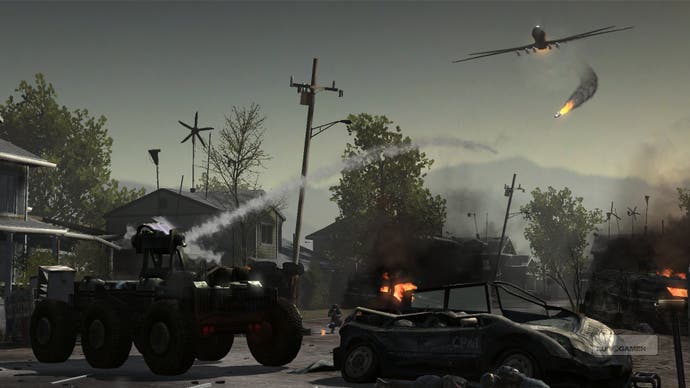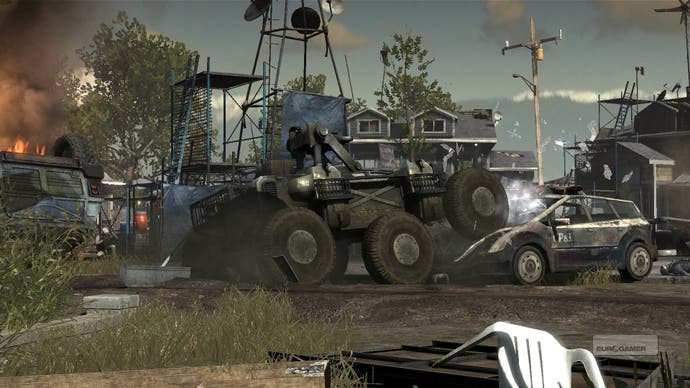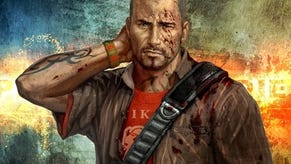E3: Homefront
Defending the US from occupation.
The Goliath, meanwhile, reflects Kaos' interest in the future of weaponry. Like Frontlines: Fuel of War, the New York developer's last game, Homefront's arsenal is a mixture of present-day equipment and things we're expecting to see soon. "We work with Richard Machowicz from Future Weapons, and he helped us with a lot of the finding out stuff that's in prototype right now and expected to go into development," says Daly. You'll also take control of various drones, and there are vehicles and aircraft to pilot directly elsewhere in the campaign.
Despite Kaos' interest in modern warfare (if not Modern Warfare), Homefront's focus on direct action and set-pieces precludes certain things, so there's no specific squad or cover system (Daly says both slowed the pace too much), although you do have comrades in arms and you can take advantage of natural cover (or unnatural, if you want to use the Goliath as a rolling barrier). The same is true of destruction. "We looked at a lot of options there and we found that when we had too much destruction in the game it kind of removed a bit of the gameplay, because those key sight-lines and cover opportunities become invalidated," says Daly. "So our approach here is that we don't destroy much of the structure of the world, but we still have a lot of flavoured destruction."
Your colleagues' AI should allow for some loose collaboration, too. "We've just actually been working on this one section where your squad-mates tell you how to use a pin-and-pass technique, where they draw the fire of the sentry tower and give you an opening to run up to the next piece of cover, and then do a kind of leapfrog approach," says Daly. "It's not like these guys are just there to provide gunfire; they're there to tell you exactly how to accomplish these objectives and what's going on in the world."

At the other end of the sights, enemy AI is still in-progress, but Daly's adamant that there will be plenty of variety. Along with the basic grunts and superior KPA troops, for instance, there are the Korean elites, the 718s, who use more aggressive flanking and cover tactics, and use drones against you. "I've actually just been working with the design team to cull the list of threat types down because we had so many and it felt like we needed to focus a bit more," he says. You certainly won't be fighting the same guys level after level.
That progression will be backed up by an evolving storyline that puts some faces to the occupation's backers, and Daly reveals that John Milius (Apocalypse Now) is working as a story consultant. "He comes down to our studio every month or so and we do a meeting with him where we run through our outline, and he gives us a lot of feedback on structure, characters, the pacing. He's a great military historian, so he'll say, 'here's how a resistance would really plan this operation', and give you a lot of specific details that add that authenticity to it." "He'll be definitely involved in the dialogue as well," adds Dunn. "He's perfect for this kind of setting and drama. Milius has written some of the great lines of all time - 'Charlie don't surf', 'I love the smell of napalm in the morning', the Dirty Harry stuff..."
Then, of course, there's the prospect of multiplayer. As with Frontlines, Kaos is promising large-scale battles taking in all sorts of vehicles, and the player count is likely to be well north of what's typical (Frontlines supported 50 players, of course). "We like the intensity and fast-paced gameplay you get in tight infantry shooters," says Daly. "You find you play a game like Battlefield or Frontlines and you get these really long sight-lines and long run distances and stuff and the pacing just drops down quite a way, so we figured out a lot of interesting systems with spawning, with progression, with just our layouts in the environment, to give this kind of interesting mix of the two - large-scale and fast-paced." How about co-op? "We won't be doing co-op in the campaign, but there's a lot of interesting elements in the multiplayer."

One thing that is noticeably absent though is a simultaneous PC launch. There will be a PC release, but Kaos says it will ship after the PS3 and Xbox 360 versions. "The question is just making sure we get the logistics worked out there," says Daly, who backs up his enthusiasm with a reminder that Kaos' background is in PC mods like Battlefield 2's Desert Combat. Sean Dunn gives a more measured publisher response: "trying to do them at the same time, it's just extremely difficult, especially when you go for different control schemes, and balance in multiplayer, and connectivity and all these things," he says. "So the idea is we don't want a port of a PC game, and nor do we want a PC version that's a port of a console game."
For now, the results are somewhere in-between: watching Homefront play out on an Xbox 360 debug unit and a massive plasma screen, it delivers the visual acuity and in-body oppressiveness of top-end PC shooters, with the set-piece swagger of their bazillion-selling console alternatives - and there's even more promise in the things we're told about but not yet shown. If it comes together, Homefront could deliver on the promise of Frontlines, and even establish its own berth in the X meets Y template of lazy preview introductions. Well find out in 2010.
Homefront is due out simultaneously for PS3 and Xbox 360, probably next year, with a PC version also planned.



